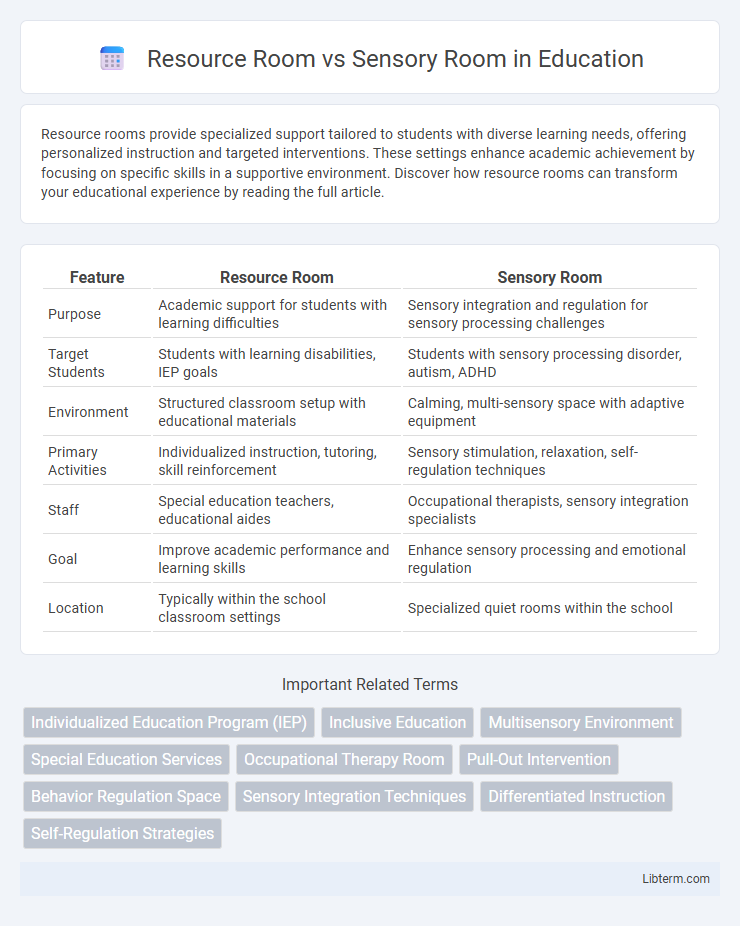Resource rooms provide specialized support tailored to students with diverse learning needs, offering personalized instruction and targeted interventions. These settings enhance academic achievement by focusing on specific skills in a supportive environment. Discover how resource rooms can transform your educational experience by reading the full article.
Table of Comparison
| Feature | Resource Room | Sensory Room |
|---|---|---|
| Purpose | Academic support for students with learning difficulties | Sensory integration and regulation for sensory processing challenges |
| Target Students | Students with learning disabilities, IEP goals | Students with sensory processing disorder, autism, ADHD |
| Environment | Structured classroom setup with educational materials | Calming, multi-sensory space with adaptive equipment |
| Primary Activities | Individualized instruction, tutoring, skill reinforcement | Sensory stimulation, relaxation, self-regulation techniques |
| Staff | Special education teachers, educational aides | Occupational therapists, sensory integration specialists |
| Goal | Improve academic performance and learning skills | Enhance sensory processing and emotional regulation |
| Location | Typically within the school classroom settings | Specialized quiet rooms within the school |
Understanding Resource Rooms: Purpose and Benefits
Resource rooms provide specialized academic support tailored to students with learning disabilities, offering targeted instruction to improve skills in reading, writing, and math. These rooms foster individualized learning plans, enabling personalized attention and adaptive teaching methods that enhance student achievement. Access to assistive technology and skilled educators in resource rooms significantly boosts students' academic confidence and independence.
What is a Sensory Room? Key Features and Uses
A sensory room is a controlled environment designed to provide multisensory stimulation through lighting, sound, textures, and interactive equipment, aimed at enhancing sensory integration and relaxation. Key features include adjustable lighting like bubble tubes, tactile surfaces, calming sound systems, and interactive tools such as weighted blankets or vibration cushions that support sensory processing disorders. Sensory rooms are commonly used in therapeutic settings for individuals with autism, ADHD, and sensory processing challenges to improve focus, reduce anxiety, and promote emotional regulation.
Core Differences Between Resource Rooms and Sensory Rooms
Resource rooms primarily provide individualized academic support and specialized instruction tailored to students with learning disabilities, focusing on skill-building and curriculum reinforcement. Sensory rooms offer a controlled environment designed to stimulate or calm the senses through therapeutic tools like weighted blankets, tactile panels, and calming lighting, aiding students with sensory processing disorders. The core difference lies in resource rooms targeting educational interventions, while sensory rooms emphasize sensory integration and regulation for emotional and behavioral support.
Target Audience: Who Benefits from Each Room Type?
Resource rooms primarily benefit students with individualized education plans (IEPs), learning disabilities, or those requiring tailored academic support, providing targeted instruction and reinforcement of classroom skills. Sensory rooms serve individuals with sensory processing disorders, autism spectrum disorder, or developmental delays, offering controlled multisensory environments to promote regulation, relaxation, and sensory integration. Both room types address distinct needs, with resource rooms focusing on academic skills and sensory rooms prioritizing sensory and emotional development.
Educational Goals in Resource Rooms vs Sensory Rooms
Resource Rooms focus on individualized academic support and skill development to enhance students' learning outcomes, targeting cognitive, communication, and social skills. Sensory Rooms are designed to regulate sensory input and promote emotional self-regulation, reducing anxiety and improving focus for students with sensory processing challenges. The educational goals in Resource Rooms emphasize curriculum mastery and adaptive learning strategies, while Sensory Rooms prioritize sensory integration and behavioral self-control.
Physical Environment: How Design Impacts Function
Resource rooms feature organized layouts with accessible educational materials and adaptive technology designed to support focused academic interventions for students with learning differences. Sensory rooms incorporate calming elements such as soft lighting, textured surfaces, and specialized equipment like weighted blankets and tactile panels to provide multisensory stimulation and promote self-regulation. The physical design of resource rooms enhances cognitive engagement through structured spaces, while sensory rooms prioritize environmental modifications that reduce sensory overload and encourage relaxation.
Staffing and Specialist Roles in Each Room
Resource rooms typically require special education teachers skilled in individualized instruction and academic support, focusing on curriculum modifications and skill development for students with learning disabilities. Sensory rooms demand specialists such as occupational therapists and sensory integration therapists who create controlled environments to address sensory processing issues and improve self-regulation. Both rooms rely on trained staff, but resource rooms emphasize educational intervention while sensory rooms prioritize therapeutic sensory experiences.
Integrating Resource and Sensory Rooms in Schools
Integrating Resource Rooms and Sensory Rooms in schools enhances support for diverse learning needs by combining targeted academic interventions with sensory regulation strategies. Resource Rooms provide specialized instruction tailored to students with disabilities, while Sensory Rooms offer controlled environments to improve focus and calm sensory overload. Coordinated use of both spaces fosters comprehensive development, addressing cognitive, emotional, and sensory challenges crucial for inclusive education.
Evidence-Based Outcomes: Research and Case Studies
Resource rooms, designed for individualized academic support, show evidence-based improvements in personalized learning outcomes, with studies highlighting enhanced reading and math proficiency for students with learning disabilities. Sensory rooms, equipped to regulate sensory input, demonstrate reduced anxiety and behavioral issues in neurodiverse populations, as evidenced by case studies reporting increased focus and emotional regulation. Combining sensory integration techniques with targeted academic interventions in these environments yields the most significant gains in student engagement and performance.
Choosing the Right Room: Factors for Decision-Makers
Choosing between a resource room and a sensory room depends on the specific needs of individuals, such as their cognitive, emotional, and sensory processing requirements. Resource rooms are designed to support academic and developmental instruction tailored for students with learning disabilities, providing focused educational interventions. Sensory rooms offer controlled sensory experiences to help regulate emotions and sensory input, benefiting those with autism, ADHD, or sensory integration challenges.
Resource Room Infographic

 libterm.com
libterm.com